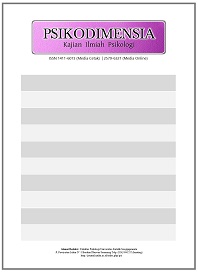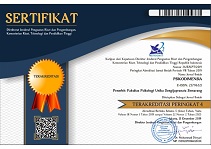Is Trust Necessary to Increase Loyalty in Adult Consumers?
Abstract
Keywords
Full Text:
PDFReferences
Alba, J. W.&Hutchinson, J. W. (1987). Dimensions of consumer expertise. Journal of Consumer Research,13(1), 411–454.
Baloglu, S. (2002). Dimensions of customer loyalty: Separating friends from well wishers.Cornell Hotel and Restaurant Administration Quarterly,43(1), 47–59.
Berg, L. (2015). Consumer vulnerability: Are older people more vulnerable as consumers than others? International Journal of Consumer Studies,39(4), 284–293.
Blau, P. M. (1964). Exchange and power in social life. New York: Academic Press.
Brakus, B., Scmitt, B. H.and Zarantonello, L. (2009). Brand eperience: What is it? How is it measured? Does it affect loyalty? Journal of Marketing, 73(3), 52–68.
Chaudhuri, A. & Holbrook, M.B. (2001). The chain of effects from brand trust and brand affect to brand performance: The role of brand loyalty.Journal of Marketing,65, 81–93.
Dawson, J.F. (2014). Moderation in management research: What, why, when, and how. Journal of Business and Psychology,29(1), 1–19.
Dekimpe, M., Steenkamp, J-B., Mellens, M.&Abeele, P. (1997). Decline and variability in brand loyalty.International Journal of Research in Marketing,14(5), 405–420.
Deshpande, R. &Krishnan, S. (1981). Correlates of deficient consumer information environments: The case of the elderly. Advances in Consumer Research,9, 515–519.
Drolet, A., Schwarz, N.&Yoon, C. (2010). The aging consumer: Perspectives from psychology and economics. New York: Routledge.
Gentile, C., Spiller, N. &Noci, G. (2007). How to sustain the customer experience: An overview of experience components that co-create value with the customer. European Management Journal,25(5), 395–410.
Global Health Observatory (GHO). (2018)Life expectancy. Retrieved from http://www.who.int/gho/mortality_burden_disease/life_tables/situation_trends/en/.
Gravetter, F. J. &Forzano, L. A. B.(2012). Research methods for the behavioral sciences (4thed.). Canada: Wadsworth Cengage Learning.
Ha, Y.H. &Perks, H. (2005). Effects of consumer perceptions of brand experience on the web: Brand familiarity, satisfaction and brand trust. Journal of Consumer Behaviour,4(6), 438–452.
Haryanto, J. T. (2017). Penduduklansiadan bonus demografikedua (Elderly population and second demographic bonus). Retrieved from KementerianKeuanganRepublik Indonesia webpage: https://www.kemenkeu.go.id/publikasi/artikel-dan-opini/penduduk-lansia-dan-bonus-demografi-kedua/
Hayes, A. F. (2013). Introduction to mediation, moderation, and conditional process analysis: A regression-based approach. New York: The Guildford Press.
Hurd, M. &Rohwedder, S. (2011). Effect of the economic crisis on the older population: How expectations, consumption, bequests, and retirement responded to market shocks (PRC WP2011-09). Philadelphia: Pension Research Council.
Iglesias, O., Singh, J. J.&Batista-Foguet, J. M. (2011). The role of brand experience and affective commitment in determining brand loyalty. Journal of Brand Management, 18(8), 570 582.
Kuikka, A.&Laukkanen, T. (2012). Brand loyalty and the role of hedonic value. Journal of Product & Brand Management, 21(7), 529–537.
Lambert-Paundraud, R., Laurent, G.&Lapersonne, E. (2005). Repeat purchasing of new automobiles by older consumers: Empirical evidence and interpretations. Jornal of Marketing,69, 97–103.
Lau, G.T. &Lee, S.H. (1999). Consumers’ trust in a brand and the link to brand loyalty.Journal of Market Focused Management,4, 341–370.
Long, N. (1998). Broken down by age and sex: Exploring the ways we approach the older adult consumer.Journal of the Market Research Society,40(2), 73–91
Matzler, K., Grabner‐Kräuter, S.&Bidmon, S. (2008). Risk aversion and brand loyalty: The mediating role of brand trust and brand affect. Journal of Product & Brand Management,17(3), 154–162.
Morgan, R. M. &Hunt, S. D. (1994). The commitment-trust theory of relationship marketing. Journal of Marketing,58, 20–38.
Morrison, S.&Crane, F. G. (2007). Building the service brand by creating and managing an emotional brand experience.Journal of Brand Management,14(5), 410–421.
Moschis, G. P. (2012). Consumer behavior in later life: Multidisciplinary approaches and methodological issues.Research in Consumer Behavior,9, 103–128.
Nysveen, H.,Pedersen, P.&Skard, S. (2013). Brand experiences in service organizations: Exploring the individual effects of brand experience dimensions.Journal of Brand Management,20(5), 404–423.
Oliver, R. L. (1999). Whence consumer loyalty?Journal of Marketing,63,33–44.
Ramaseshan, R.&Stein, A. (2014). Connecting the dots between brand experience and brand loyalty: The mediating role of brand personality and brand relationships.Journal of Brand Management, 2, 664–683.
Şahin, A.,Zehir,C.&Kitapçi, H. (2011). The effects of brand experiences, trust and satisfaction on building brand loyalty: An empirical research on global brands.Procedia-Social and Behavioral Sciences,24, 1288–1301.
Schmitt, B. H.&Rogers, D. L. (2008). Preface. In: B.H. Schmitt and D.L. Rogers (eds.)Handbook on brand and experience management(pp. ix–x). Cheltenham, UK: Edward Elgar.
Singh, J. J., Iglesias, O.&Batista-Foguet, J. M. (2012). Does having an ethical brand matter? The influence of consumer perceived ethicality on trust, affect and loyalty.Journal of Business Ethics,111(4), 541–549.
Sousa, V. D. &Rojjanasrirat, W. (2011). Translation, adaptation and validation of instruments or scales for use in cross‐cultural health care research: A clear and user‐friendly guideline. Journal of Evaluation in Clinical Practice, 17(2), 268–274.
Triandis, C.H., Bontempo, R., Villareal, M.J., Asai, M. &Lucca, N. (1988). Individualism and collectivism: Cross-cultural perspectives on self-ingroup relationships. Journal of Personality and Social Psychology,54(2), 323–338.
DOI: https://doi.org/10.24167/psidim.v17i2.1658
Print ISSN : 1411-6073 | online ISSN : 2579-6321 View My Stats

This work is licensed under a Creative Commons Attribution 4.0 International License.





















